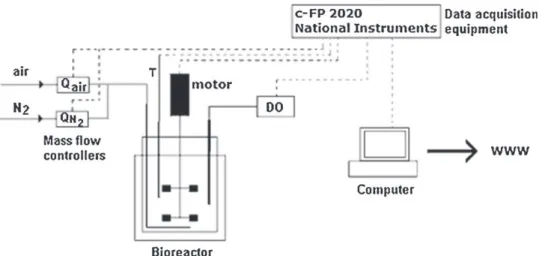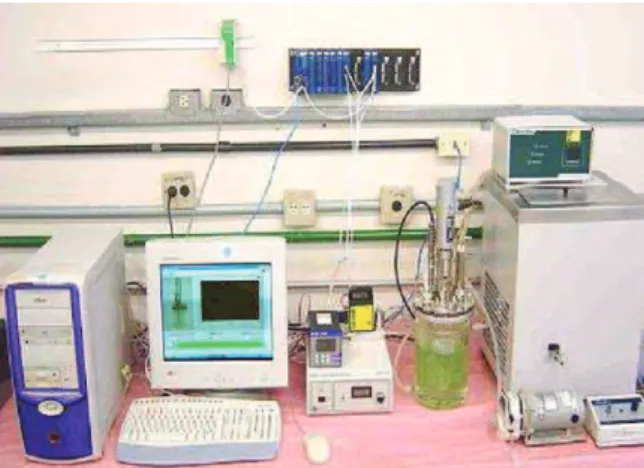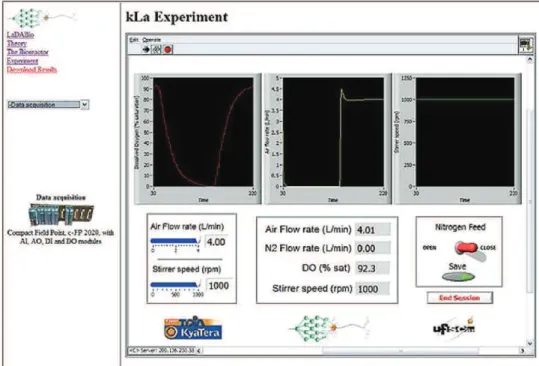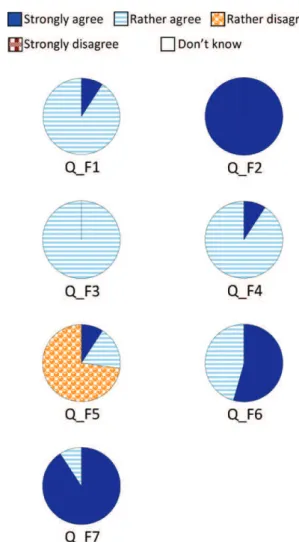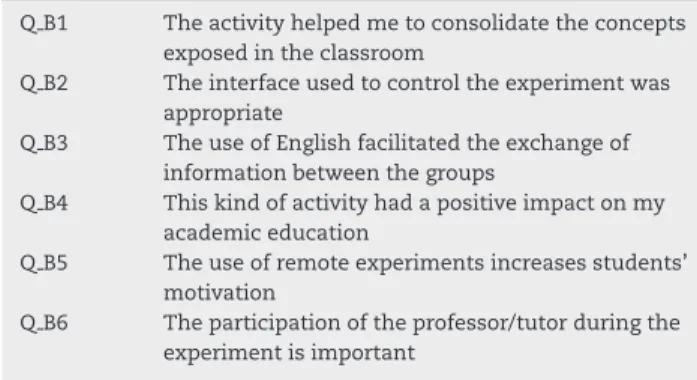HAL Id: hal-00878668
https://hal.archives-ouvertes.fr/hal-00878668
Submitted on 30 Oct 2013
HAL is a multi-disciplinary open access
archive for the deposit and dissemination of
sci-entific research documents, whether they are
pub-lished or not. The documents may come from
teaching and research institutions in France or
abroad, or from public or private research centers.
L’archive ouverte pluridisciplinaire HAL, est
destinée au dépôt et à la diffusion de documents
scientifiques de niveau recherche, publiés ou non,
émanant des établissements d’enseignement et de
recherche français ou étrangers, des laboratoires
publics ou privés.
Cooperative WebLab in chemical engineering between
France and Brazil: Validation of the methodology
Marion Alliet-Gaubert, Galo Carrillo Leroux, Charles D.F. de Jesus, Antonio
J.G. Cruz, David Rouzineau, Roberto C. Giordano, Xavier Joulia, Claudio
A.O. Nascimento
To cite this version:
Marion Alliet-Gaubert, Galo Carrillo Leroux, Charles D.F. de Jesus, Antonio J.G. Cruz, David
Rouzineau, et al.. Cooperative WebLab in chemical engineering between France and Brazil:
Vali-dation of the methodology. Education for Chemical Engineers, Elsevier, 2012, vol. 7, pp. e7-e13.
�10.1016/j.ece.2011.09.001�. �hal-00878668�
O
pen
A
rchive
T
OULOUSE
A
rchive
O
uverte (
OATAO
)
OATAO is an open access repository that collects the work of Toulouse researchers and
makes it freely available over the web where possible.
This is an author-deposited version published in :
http://oatao.univ-toulouse.fr/
Eprints ID : 9967
To link to this article : doi:10.1016/j.ece.2011.09.001
URL :
http://dx.doi.org/10.1016/j.ece.2011.09.001
To cite this version : Alliet-Gaubert, Marion and LeRoux, Galo
Carrillo and De Jesus, Charles D.F. and Cruz, Antonio J.G. and
Rouzineau, David and Giordano, Roberto C. and Joulia, Xavier and
Nascimento, Claudio A.O. Cooperative WebLab in chemical
engineering between France and Brazil: Validation of the methodology.
(2012) Education for Chemical Engineers, vol. 7 (n° 1). pp. e7-e13.
ISSN 1749-7728
Any correspondance concerning this service should be sent to the repository
administrator:
staff-oatao@listes-diff.inp-toulouse.fr
Cooperative
WebLab
in
chemical
engineering
between
France
and
Brazil:
Validation
of
the
methodology
Marion
Alliet-Gaubert
a,∗,
Galo
Carrillo
LeRoux
b,
Charles
D.F.
de
Jesus
c,1,
Antonio
J.G.
Cruz
c,
David
Rouzineau
a,
Roberto
C.
Giordano
c,
Xavier
Joulia
a,
Claudio
A.O.
Nascimento
baUniversitédeToulouse–INPT-ENSIACET,4,AlléeEmileMonso,BP44362,310030Toulouse,Cedex04,France
bDepartamentodeEngenhariaQuímica,EscolaPolitécnicadaUniversidadedeSãoPaulo,Av.Prof.LucianoGualberto,Trav.3,380,
05508-900SãoPaulo,SP,Brazil
cDepartamentodeEngenhariaQuímica,UniversidadeFederaldeSãoCarlos,RodoviaWashingtonLuis(SP310),km235,13565-905São
Carlos,SP,Brazil
a
b
s
t
r
a
c
t
AWebLabisanexperimentoperatedremotelyviaInternet.Besidesthestrictlytechnicalaspectsofsuchan experi-ment,whichmaycontributetothelearningofChemicalEngineeringfundamentals,thereisalsoimportantfeedback whenteamsofstudentsoftwodifferentcountriesareworkingtogether:theWebLabbecomesanintercultural expe-rience,enhancingthecommunicationskillsofthestudents.AWebLabbetweenUniversidadeFederaldeSãoCarlos (DEQ/UFSCar)andtheEcoleNationaleSupérieured’IngénieursenArtsChimiquesetTechnologiques(ENSIACET)is presentedinthiswork.Amasstransferexperimentinabenchscalereactor(stirredandaerated)hadtobestudiedby mixedteams,thusemulatingchallengesthatwillbecommoninfutureworkingenvironments.Inordertoperform theexperiment,studentsinBrazilandinFrancewereputintogroups.Thestudentshadtomakedecisionsaboutthe procedureforexecutingtheexperiments.Allthestudentswereabletocontroltheequipment,nomatterwherethey werephysically.Studentscommunicatedusingvideoconferencesoftware.Thestudents’andteachers’opinionsof thisexperiencewereverypositive.Thismethodologyisanimportantcontributiontotheeducationofengineersin aworldintegratedbymoderncommunicationtechnologies.
Keywords: CooperativeWebLab;Internetexperiment;Chemicalengineering;iLabs
1.
Introduction
Onlinelaboratories(“WebLabs” or“iLabs”)are experimental setupsthatcanbeaccessedthroughtheInternetfroma reg-ularwebbrowser.iLabwasborninmicroelectronicsclasses taughtbytheelectricalengineeringprofessorJesusdelAlamo ofMIT,in1998(iLabprojecthomepage,2011).Fromtimeto time,thisconceptisusedbyotherdisciplineslikechemical engineering(HenryandKnight,2003;Kleinetal.,2005;Shin etal.,2002).
∗ Correspondingauthor.Tel.:+33534323630;fax:+33534323399.
E-mailaddresses:Marion.Alliet@ensiacet.fr(M.Alliet-Gaubert),galoroux@usp.br(G.C.LeRoux),cdfcdf2@yahoo.com, charles.jesus@bioetanol.org.br(C.D.F.deJesus),ajgcruz@ufscar.br(A.J.G.Cruz),David.Rouzineau@ensiacet.fr(D.Rouzineau), roberto@ufscar.br(R.C.Giordano),Xavier.Joulia@ensiacet.fr(X.Joulia),oller@usp.br(C.A.O.Nascimento).
Received13July2011;Receivedinrevisedform12September2011;Accepted15September2011
1 CurrentlyatCTBE–LaboratórioNacionaldeCiênciaeTecnologiadoBioetanol,RuaGiuseppeMáximoScolfaro,n◦10.000BairroGuará,
DistritodeBarãoGeraldo,Campinas,SP,Brazil.
InaworkshopaboutWebLabsinChemicalEngineeringthat tookplaceinCambridge,UK(SelmerandKraft,2011;Moros, 2005),threemainkindsofWebLabusewerefoundtobethe mostpromising:
1. Verysmallsetupsofafewcentiliters(Moros,2005;Selmer etal.,2005)thatdonotneedtobelocallysupervised.Their main advantageis more convenient access to the labs. Experimentscanbecarriedoutfromanywhereatanytime. 2. Pilot-scalesetupsfromafewliterstotensofliters,which
Fig.1– ExperimentalsetupusedforkLadetermination.
areconductedbytwogroupsofpeople:onegroupclose totheequipment,theotheranywhereintheworld.Their mainadvantagesare,first,toenabletheplanttobe oper-atedfromfarawayasisincreasinglydoneinindustryand, second,topromoteinterculturalexchanges.
3. Specific experiments that are used few times and are expensive.Morepeoplecanaccesssuchequipment,thus contributingtoitsfinancialequilibrium.
An experimental setup for the determination of mass transfer coefficient was prepared for remote experiments attheLaboratoryforDevelopment and Automationof Bio-chemical Processes (LaDABio) of the Chemical Engineering Department of the Universidade Federal de São Carlos (DEQ/UFSCar)withthesupportoftheKyateraprogram.This programwasestablishedbytheSãoPauloStateAgencyfor Research Development (FAPESP) to study and develop the useoftechnologyandapplicationsinadvancedInternetfor research and educational purposes (KyaTera). One of the projectsthatoriginatedinKyateraisthe“ClusterofWebLabs forChemical and BiochemicalProcess Engineering”,which aimstodevelopasetofrealexperiments,availablethrough theInternet,forchemicalengineeringstudentsat undergrad-uatelevel.OtherKyaTeraprojectsandtheannualreportcan befoundathttp://www.kyatera.fapesp.br.
In order to validate the methodology, a WebLab was implementedbetweenLaDABioandtheProcessEngineering DepartmentoftheEcoleNationaleSupérieured’Ingénieursen ArtsChimiquesetTechnologiques(ENSIACET).
OneofthemainobjectivesofthisWebLabexperimentisto offerstudentsinterculturalexperiencewhileenhancingtheir communication skills.Atthe same time, atechnical prob-lemhastobesolvedbyheterogeneousteams,thusemulating challengesthatwillbecommonintheirfuturework environ-ment.And,last but notleast, eventhoughtheobjective of thisWebLabisnottoreplaceactualexperiments,ithelpsin theassimilationofconceptsconcerningChemical Engineer-ingfundamentals.Toachievethesegoals,thestudentsofboth countriesarerequiredtoworkinsynergy.
During 4differentsessions,14 students from ENSIACET and8studentsfromDEQ/UFSCarwereinvitedtostudya sys-temphysicallylocatedatLaDaBiousingremoteaccess.The WebLabconsistedofamasstransferexperimentina bench-scale reactor(stirredand aerated). Theexperimentapplied thegassing-outdynamicmethodtodeterminethevolumetric
oxygenmasstransfercoefficient(kLa)fordifferentconditions
ofstirringandaeration.
Inordertoperformtheexperiment,twostudentsinBrazil andthreeorfourinFranceworkedasagroup,supervisedby teachersofeachcountry.Thestudentshadtodecideonthe measurementsthatweretobemadeandontheexperimental protocols(whocontrolswhat).AsonlythestudentsinBrazil wereabletointeractphysicallywiththesystem,web-cameras wereinstalledinordertoallowthestudentsinFranceto fol-lowthe experimentvisually.Studentscommunicated using conventionalvideoconferencesoftware.
Each student was invited to answer a questionnaire intended to assess his/her expectations before the experi-ment,and anotheroneafterthe finalreportwasreturned. Thisworkcompilestheopinionsofthestudentsand teach-ersinordertosketchaportraitofthepedagogicalimpactof thistypeofexperiment.
2.
Determination
of
mass
transfer
coefficient
(k
La
):
theory
Duringtheaerobicgrowthofmicroorganismsorcellsintank bioreactors,thelevelofdissolvedoxygenmustbekepthigh enoughfortheorganismstothrive.Itisimportantforfuture (bio-)chemicalengineerstomasterthefundamentalsofmass transferinvolved,andalsotobecomeacquaintedwith tech-niques forassessingrates ofoxygen transferfrom thegas phaseintotheliquidculturemedium.
The method usedin the WebLab to determine kLa was
the unsteady statemethod (“Gassing-out Method”). In this method, the dissolved oxygen is removed from the liquid phasebyspargingnitrogenintothemedium.Whenthe dis-solvedoxygenconcentration(DO)reachesavalueofzero,the nitrogenfeedisinterruptedandtheairflowisrestarted.DO ismonitoreduntilthesolutionisnearlysaturated.Assuming idealmixingintheliquidphase,themassbalanceforDOin theliquidphaseduringthere-aerationcanbeexpressedby Eq.(1).
dC
dt =kLa·(C
∗
−C) (1)
whereC*istheDOsaturationconcentrationandCistheDO concentration
Eq.(1)issuitablewhenfastprobesareemployed.Ifafast probeisnotavailable,thedynamicsoftheelectrodeshould
Fig.2–Photographofthehardwareusedforimplementing theWebLabinLaDABio.
be considered.The response of modern electrodes can be describedasafirst-ordersystem,givenbyEq.(2).
dCe
dt = 1 E(C
−Ce) (2)
whereCeistheDOmeasuredbytheelectrodeand Eisitstime
constant.
CombiningEqs.(1)and(2)andsolvingforCe,givesEq.(3).
Ce =Ce0·e−((t−t0)/ E)+C
es·(1−e−((t−t0)/ E))
+(1/ E)·(Ces−C0) (1/ E)−kLa
·(e−((t−t0)/ E)−e−kLa·(t−t0)) (3) whereC0istheDOconcentration(attimet0),Ce0istheDO
measuredbytheelectrodeatre-aeration(attimet0),Cesisthe
DOconcentrationatsteady-state.
Theparameter kLais estimatedby fitting Eq. (3) tothe
experimental data by means of a nonlinear least-squares algorithm.Foraccurateresults,thecriterion E≪1/kLais rec-ommended(BadinoJr.etal.,2000).
3.
Experimental
facilities
TheWebLab systemwas implementedemploying National InstrumentshardwarefordataacquisitionandLabVIEW®as
thesupervisorysystem.AsketchoftheimplementedWebLab isshowninFig. 1anda picture ofthe experimentalsetup isshowninFig.2.InTable1,theresourcesavailableforthis WebLabarepresented.
TheuserinterfacewasdevelopedusingLabVIEW7.0and was hosted ina framed web page.This approach allowed theusertoaccessinformationabouttheexperiment(theory, recordeddata,etc.)withoutleavingtheLabVIEWinterface.
Fig.3showsascreenshotoftheprincipal webpageand Fig.4depictsthemaininterfaceoftheexperiment.Attheend ofeachexperimentalsession,thestudentssavedthecollected dataforfurtheroff-lineanalysis,inordertodeterminekLa.
4.
The
exercise
“Gas–LiquidAgitatedTank”isasecond year experimentof ChemicalEngineeringatEcoleNationaled’IngénieursenArts ChimiquesetTechnologiques.Itsaimistogivethestudents indispensable knowledge on stirred tanks. At the present time,therearenoclassesdedicatedtothisspecifictopicbut
thestudentsborrowtheconceptfromvariousothercourses (transportphenomena,masstransfer...).
Theactivitywasdividedintothreeparts:
1. Preparatory experimental work was done, in France, in ordertoenablethestudentstoidentifyandcalculate spe-cificparameters(powernumberNp,kLa)fromexperimental
dataacquiredfroma100Lstirredtank.Thisexperiment wasperformedonlyinFrancebecausethesetupdiffered fromthatinBrazil.StudentsinBrazildidnothavetodo theexperimentbeforehand.
2. AnexperimentalWebLabsession,withaccessandcontrol, inFrance,ofthesystemphysicallylocatedinBrazil. 3. Processingofthedataobtainedduringthe experiments,
analysis of the results obtained and further discussion abouttheimportanceoftheparameterscalculated. For the first part, groups of four French students spent two half-days studying the general behavior of a stirred tank located at AIGEP (Atelier Interuniversitaire de GéniedesProcédés: http://www.inp-toulouse.fr/fr/aussi-sur-le-campus/aigep.html).Partoftheirworkwasdevotedtothe determinationofthepower number(Np)ofaRushton
Tur-bine.TheystudiedtheevolutionofNpfordifferentstirring
speedsandfordifferentfluids(air,water,andwater+air).The secondobjectiveofthepracticalexercisewasthe determina-tionoftheoverallvolumetricoxygenmasstransfercoefficient (kLa)accordingtoEq.(3),forthevariousexperimental
condi-tionstested.Duringalltheseexperiments,specialattention waspaidtothegasholdup(ε),thesizeofthebubblesand thedispersionregime.Fromthedata,thestudentscritically comparedtheirexperimentalresultstoempiricalcorrelations foundinthe literature.BeforetheWebLabsession,the stu-dents received the main guidelines from the teacher and discussedthedifferencesbetweenthetwosystemsandhow tochoosenewexperimentalconditionsinordertoobtain com-parableresults.
For the second part, the French tutor logged on to the WebLab at http://ladabio.deq.ufscar.br and the use of the Graphical UserInterface (developedin LabVIEW®
) was explainedtothestudents.Inordertofacilitatethe communi-cationbetweenthegroups,Skype®chatviawebcamwasused.
First,thestudentsofeachcountryintroducedthemselvesand then,aspartoftheWebLabexperiment,theFrenchstudents statedthepreciseexperimentalconditionstheywantedtotest andexplainedwhytheyhadchosenthem.
During the French access, the Brazilian students acted asasupportinggroup,providinginformationaboutthe sys-temphysicalcharacteristics(e.g.,size,volume)andconditions (e.g.,temperaturebeforeandaftertheexperiment).Afterthe endoftheFrenchsession,theysavedthesamelogfile(for fur-theranalysis)and,whennecessary,accessedtheexperiment totestnewconditionsandtoclarifyanyremainingdoubts.
Throughout the experiments, the students exchanged information and opinions about the phenomena that took placeinthestirredtank.Theirmainconcernswereaboutthe quality ofthemixing, the sizeofthe bubbles andthe var-iousproblemsthat arise duringsuchexperiments(bubbles blockingthetipoftheprobe,highcoalescencephenomena, conditionsofinefficientmixing...).Modelingthedynamical system was part ofthe work, but it was not addressedin thecaseoftheFrenchexperiment.Whenthesystemdidnot respondastheyexpected,thestudentsdecidedcollectively whichparametertheyshouldmodifyusingtheirtheoretical
Table1–WebLabresources.
Resource Description
Bioreactorandmotor (Bio)reactorwithjacket(ApplikonBV,Switzerland),2Lworkingvolume,motor/impeller(0–1200rpm) Moduleforstirrercontrol Usedtomanipulatethestirrerspeed,4–20mAsignal(ApplikonBV,Switzerland)
Thermostatizedbath Withrecirculation(NovaEtica,Brazil);waterispumpedthroughthebioreactorjacket Massflowcontroller Controlsandmeasuresairflowratesintothebioreactor,4–20mAsignal(Aalborg,USA) DOtransmitter AmplifiesDOprobesignal(Mettler-Toledo,Switzerland)
DOprobe MeasuresDOinthemedium(Mettler-Toledo,Switzerland) Thermoresistance/transmitter Measuresthetemperatureinthemedium(Pt-100,Exacta,Brazil)
Dataacquisition CompactFieldPoint,c-FP2020,withAI,AO,DIandDOmodules(NationalInstruments,USA)
Fig.3–Screenshotofthewebpageaccessedbythestudents. background.Oncetheyhadsetthechosenconditions,thedata
wereloadedthroughtheinterfaceandrecordedinalogfile. Duringtheactivity,itwasclearthatahighlevelof interac-tionoccurredamongthestudents,whotalkedanddiscussed throughouttheirwork.
Aftertheexperimentalsession,thestudentsprocessedthe data collected in order to calculate kLa and wrote generic
reports. Knowing the value of the time constant of the electrode and assuming that the response time could be describedusingafirst-orderequation,thestudentsestimated
the parameter kLa by fitting a theoretical equation to the
experimentaldatausinganonlinearleastsquaresalgorithm (MS-Excelsolver). Afterthis experiment,the studentswere expectedtobeabletogiveexplanationsforthediscrepancies betweenthemodelandtheexperimentaldata,torealizethat, fortanksofdifferentsizes,relevantparametersdonothave thesameimportance,andtoexplainwhykLavaluesobtained
fromtheBrazilianandFrenchsystemsweredifferent.
5.
Practical
considerations
Theorganizationofthetimetablewasthefirstchallengeto befaced.TheWebLabexperimentcouldonlybeheldbetween themonthsofMarchandAprilduetoAIGEP’sbusy sched-ule.Asthe Brazilianacademicyear beginsinFebruary,the Brazilianstudentsdidnothavetimetobecomeasfamiliar withtheexperimentastheFrenchstudents,whoseacademic yearhadbegun7monthsearlierandwhohaddonearelated experimentafewdaysbefore.Thisdidnotseemtoimpactthe experimenttoomuchbuttheBrazilianteachersmayhavehad togivemoreexplanations.
Thetime delay betweenFrance and Brazil was another challenge.First,itforcedthegroupstoworkatdifferenttimes ofday:afternooninFranceandmorninginBrazil.Inaddition, theWebLabexperimentswerecarriedoutduringtheperiodof changefordaylightsavingtime.Thechangeintime-difference fromfivehourstothreehourscomplicatedtheorganization.
Anotherchallenge concerned the softwareadjustments. AlthoughtheinterfacedevelopedbytheBraziliangroup oper-atesextremelywell,afewproblemsrelatedtothedatatransfer rateoftheInternetconnectionoccurred.Forexample,ifthe videooftheexperimentwasenabled,itwasdifficultto visu-alizewhathappenedinthestirredtankinrealtimebecause ofthedelaybetweenframes.
Thesethreepointsshowthatsomeimprovementsneedto beimplementedandthatverygood“practical”organizationis crucialinordertorunaWebLabexperimentatsuchadistance. Therewasasecond,moresubjectivekindofchallenge.One ofthemainobjectivesofWebLabistoofferintercultural expe-riencetostudents.Itisinterestingtoobservethattherewasa highlevelofinteractionamongthemduringtheactivity:they chattedanddiscussedallthetime.However,thechatwasnot exclusivelyabouttechnicalaspectsoftheexperiment!
Theseexperimentsalsoofferedtheteachersintercultural experienceon their teaching context.Ageneraland previ-ousagreementneededtobefoundbetweenthetwoteachers inordertosupervisethestudentscorrectlyduringtheclass. Fromapedagogicalpointofview,itwasalsohighlyinstructive toseehowtheothersupervisorexplainedthesame phenom-enatohis/herstudents.ItwasnoticedthattheFrenchteachers gaverather moreimportancetothetheory whereas Brazil-ianteachersweremoreconcrete.Moreovertherelationship betweenteachersandstudentsseemedmorefamiliarinBrazil andmoreformalinFrance.
Communicationbetweenteachers,althoughpleasant,was notalwaysobvious.Forexample,thequestionnairesubmitted tothestudentscontaineddifferentquestionsforthetwosides ofthe Atlantic Ocean because culturaldifferences implied timeforadjustment,whichwas notplanned.For example, thechoicesintheanswersweredifferentforculturalreasons: Frenchteacherswantedtheirstudentstoagreeor disagree (avoidingneutralstatements)buthavetheopportunitytonot haveanyopinion,whereasBrazilianinstructorswantedtheir
Table2–QuestionspresentedtotheFrenchstudents.
Q F1 Ienjoydoingthis
QF2 Beingintouchwithstudents8000kmawayis interesting
QF3 Thislaboratoryisinteresting
QF4 Thislaboratoryiswellsituatedinmyeducation program
QF5 Thislaboratoryisrelevanttomyprogram QF6 Thislaboratorywillbedoneagainnextyear Q F7 WebLabwilldevelop
studentshavetheopportunitytopartlyagree,partlydisagree, buttoexpressanopinion.
6.
Students’
opinions
French students answered questionnaires before and after doingtheexperiment.Thesequestionnairescontained ques-tions about the previous relationships of students with foreignersandtheiropinionsabouttheWebLabexperiment. TheselastquestionsarepresentedinTable2andtherelated syntheticanswersareshowninFig.5.Asimilarquestionnaire wasansweredbytheBrazilianstudentsaftertheexperiment. Table3presentsthe questionsinthequestionnaires.Fig.6 showstheanswersoftheBrazilianstudents.
First, Frenchstudents hadalready been abroad,86%for shortperiodsand14%forlongstays.71%thoughtthatthey spoke aforeign languagecorrectlyand29%thattheydidit
Table3–QuestionspresentedtotheBrazilianstudents.
Q B1 Theactivityhelpedmetoconsolidatetheconcepts exposedintheclassroom
QB2 Theinterfaceusedtocontroltheexperimentwas appropriate
QB3 TheuseofEnglishfacilitatedtheexchangeof informationbetweenthegroups
QB4 Thiskindofactivityhadapositiveimpactonmy academiceducation
QB5 Theuseofremoteexperimentsincreasesstudents’ motivation
Q B6 Theparticipationoftheprofessor/tutorduringthe experimentisimportant
poorly.64%hadhadnoworkingexperiencewithforeigners, 29%hadhadafewmeetingsand7%longtrainingperiods.
FortheiropinionabouttheWebLabexperiment,although thequestionswerenotaskedinthisorder,wehavegrouped theminthree sets:the first concerningwhat theythought about thisnew typeofteaching (Q F1,Q F2and Q F3),the secondhowtheyconsideredthisteachingexperienceinthe context oftheirwhole education program(QF4 and QF5), andthelastwhattheythoughtaboutthefutureofWebLab (QF6andQF7).AscanbeseenonFig.5,theyconsistently likedtheconceptofWebLab.Theyweredividedaboutthe ade-quacyofWebLab totheir educationprogram(thiscould be becausethesestudentswerefromIndustrialEngineeringand theymayhavepreferredcontrolledexperimentstoatypical chemicalengineeringexperiment.Finally,theythoughtthat WebLabshouldbecontinued andwoulddevelop.Moreover, twogroupsofFrenchstudentsreportedthatthisexperience hadencouragedthemtothinkaboutalongtrainingperiodina foreigncountryandmostofthemthoughtthatithelpedthem todemystifytheconceptofworkingwithpeopleoverseas.
Theunderstandingoftechnicalandscientificconceptswas evaluatedthroughareportfortheFrenchstudents(asusual forpracticalworks).There was nosignificant difference in
Fig.6–Brazilianstudents’answers.
learningbetweenthestudentswhichperformedtheWebLab andthosewhofacedactualexperimenttwicemoretime.
AmongtheBrazilianstudents,nonechosetheoptions “Dis-agree”or“Stronglydisagree”foranyquestion.Mostofthem thoughtthatthiskindofactivityhadapositiveimpactontheir education(QB4)and,despiteEnglishnotbeingtheirmother tongue,theythoughttheywere abletocommunicate prop-erly(QB3).ItisinterestingtonotethatnoneoftheBrazilian studentschose“Stronglyagree”forQ B1.Asacomplement, they reinforcedthe importanceofateachertoguide them (QB6).TheyagreedthatthemotivationalaspectoftheWebLab is appealing, but a fewstudents did not enjoythe experi-mentthatmuch(Q B5).Despitesomeconcerns,thestudents approvedtheuserinterfaceusedtocontroltheWebLab(Q B2). Theinterpretationoftheseanswersledtotheconclusion thattheuseofWebLabsfostersinterestinstudents,butthat caremustbetakenwhenpreparingthetheoreticalcontent oftheclassandwhenimplementingtheexperimentandthe userinterfacetocontrolit.
7.
Conclusions
Theimplementation ofWebLabs isnotvery expensiveand offersinterculturalexperiencetostudents, inavarietythat couldnotbeobtainedwithoutthenewcommunication tech-nologies. It emulates challenges that will be common in students’futureworkingenvironment.Theunderstandingof technical and scientific concepts was evaluated through a reportforthe Frenchstudents(asusualforpracticalwork). Therewasnosignificantdifferenceinlearningbetweenthe students who participated in WebLab and those who did not. And, last but not least, without replacing an actual experiment,theinteractiveWebLabhelpstheassimilationof conceptsconcerningChemicalEngineeringfundamentals.As thestudentsofbothcountriesworkinsynergythis method-ology is an important contribution to the development of engineersinaworldintegratedbymodern communication technologies.Evenifitisdifficulttoevaluatethelong-term benefits(forexampleontheinternationalizationofstudent careers), the questionnairesshowed that students’ opinion onthisexperiencewasverypositive.Thisinvolvement cor-respondstoanadditionalmotivation forthe furtheruseof thistechnologyinteachingactivities.
Acknowledgment
TheauthorswouldliketoacknowledgetheKyaTeraProjectof theFundac¸ãodeAmparoàPesquisadoEstadodeSãoPaulo (FAPESP–ProcessNumber03/08155-1).
References
BadinoJr.,A.C.,Facciotti,M.C.R.,Schmidell,W.,2000.Improving
kLadeterminationinfungalfermentation,takingintoaccount
electroderesponsetime.JournalofChemicalTechnologyand Biotechnology75,469–474.
Henry,J.,Knight,C.,2003.Modernengineeringlaboratoriesata distance.IntJ.EngngEd.19(3),403–408.
iLabprojecthomepage,2011.https://confab.mit.edu/ confluence/display/ILAB2/Home(accessed21.03.11). Klein,A.,Hausmanns,C.,Wozny,G.,2005.Web-basedremote
experimentswitharealtechnicalplantinchemical
engineeringeducation.In:AIChEAnnualMeeting,October30 toNovember4,2005,Cincinnati,OH,USA.
Moros,R.,2005.VIPRATECH,OurWaytoanOnlineLaboratoryin ChemicalEngineeringandUnitOperations,http://como. cheng.cam.ac.uk/pdfs/workshop/ralfmorosws.pdf(accessed 23.03.11).
Selmer,A.,Goodson,M.,Kraft,M.,Sen,S.,McNeill,V.F.,Johnston, B.S.,Colton,C.K.,2005.Performingprocesscontrol
experimentsacrosstheAtlantic.ChemicalEngineering Education39(3),232–237.
Selmer,A.,Kraft,M.,2011.http://como.cheng.cam.ac.uk/conf. workshop.html(accessed23.03.11).
Shin,D.,Yoon,E.S.,Lee,K.Y.,Lee,E.S.,2002.Aweb-based interactivevirtuallaboratorysystemforunitoperationsand processsystemengineeringeducation:issues,designand implementation.ComputersandChemicalEngineering26, 319–330.
